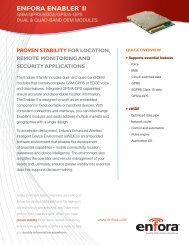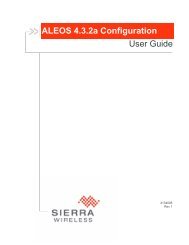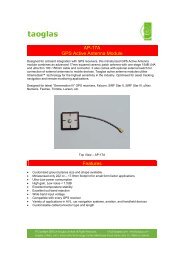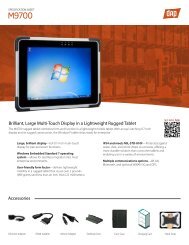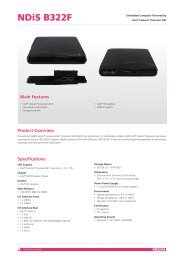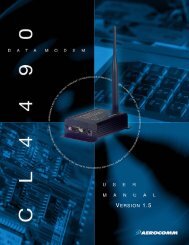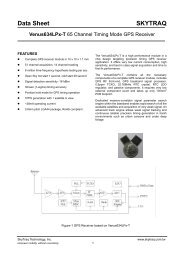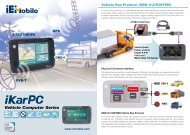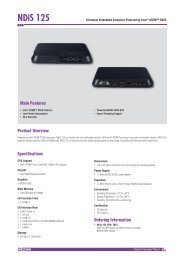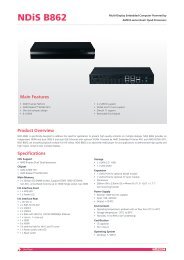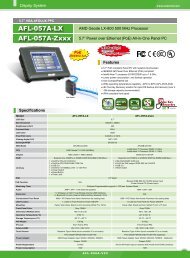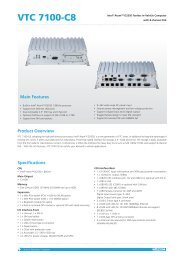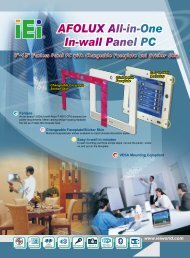Aerocomm AC4868.pdf - HEAnet Mirror Service
Aerocomm AC4868.pdf - HEAnet Mirror Service
Aerocomm AC4868.pdf - HEAnet Mirror Service
Create successful ePaper yourself
Turn your PDF publications into a flip-book with our unique Google optimized e-Paper software.
www.aerocomm.com<br />
SERIAL INTERFACE<br />
supported. For a baud rate to be valid, the calculated baud rate must be within ±3% of the OEM Host baud rate. If the<br />
Test pin (Pin 12) is pulled logic Low at reset, the baud rate will be forced to 9,600.<br />
Baud Rate<br />
57,600 1<br />
BaudL<br />
(0x42)<br />
INTERFACE TIMEOUT / RF PACKET SIZE<br />
Interface Timeout (EEPROM address 0x58), in conjunction with RF Packet Size (EEPROM address 0x5B), determines<br />
when a buffer of data will be sent out over the RF as a complete RF packet, based on whichever condition occurs first.<br />
Interface Timeout – Interface Timeout specifies a maximum byte gap between consecutive bytes. When that byte gap<br />
is exceeded, the bytes in the transmit buffer are sent out over the RF as a complete packet. Interface Timeout is<br />
adjustable in 0.5ms increments and has a tolerance of ±0.5ms. Therefore, the Interface Timeout should be set to a<br />
minimum of 2. The default value for Interface Timeout is 0x04 (2ms) and should be adjusted accordingly when<br />
changing the transceiver baud rate.<br />
RF Packet Size – When the number of bytes in the transceiver transmit buffer equals RF Packet Size, those bytes are<br />
sent out as a complete RF packet. It is much more efficient to send a few large packets rather than several short<br />
packets as every packet the transceiver sends over the RF contains extra header bytes which are not included in the<br />
RF Packet Size. However, if the RF Packet Size is set too large, the transceiver will not be able to send any packets<br />
because the AC4868 requires the entire RF packet to be sent in the same hop period (53 ms). The RF packet size if<br />
programmed in EEPROM automatically when Auto Config is enabled. It is strongly recommended that Auto Config be<br />
left enabled to maximize the efficiency of the transceiver.<br />
FLOW CONTROL<br />
Table 6: Baud Rate / Interface Timeout<br />
BaudH<br />
(0x43)<br />
RF Baud<br />
(not<br />
adjustable)<br />
Minium Interface<br />
Timeout (0x58)<br />
Stop Bit Delay (0x3F)<br />
0xFC 0x00 28,800 0x02 0x03<br />
38,400 0xFA 0x00 19,200 0x02 0x08<br />
28,800 0xF8 0x00 28,800 0x02 0x0E<br />
19,200 0xF4 0x00 19,200 0x03 0x19<br />
14,400 0xF0 0x00 28,800 0x04 0x23<br />
9,600 0xE8 0x00 19,200 0x05 0x39<br />
4800 0xD0 0x00 28,800 0x09 0x7A<br />
2400 0xA0 0x00 19,200 0x11 0xFC<br />
1200 0x40 0x00 28,800 0x21 0x00 2<br />
1. 57,600 is the default baud rate<br />
2. 0x00 will yield a stop bit of 421 uS. The stop bit at 1200 baud should actually be 833 uS.<br />
Flow control refers to the control of data flow between transceivers. It is the method used to handle data in the<br />
transmit/receive buffer and determines how data flow between the transceivers is started and stopped. Often, one<br />
9



